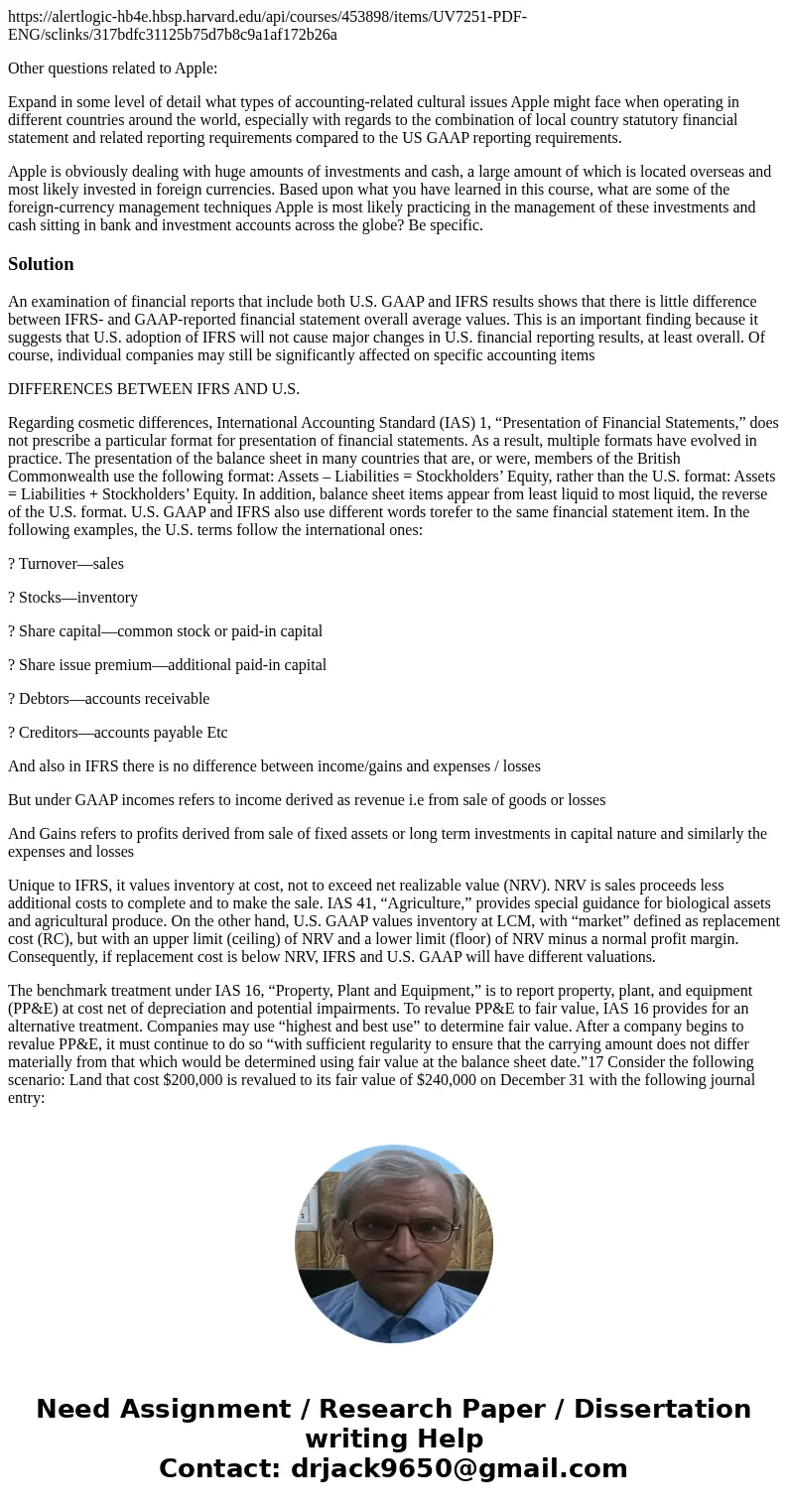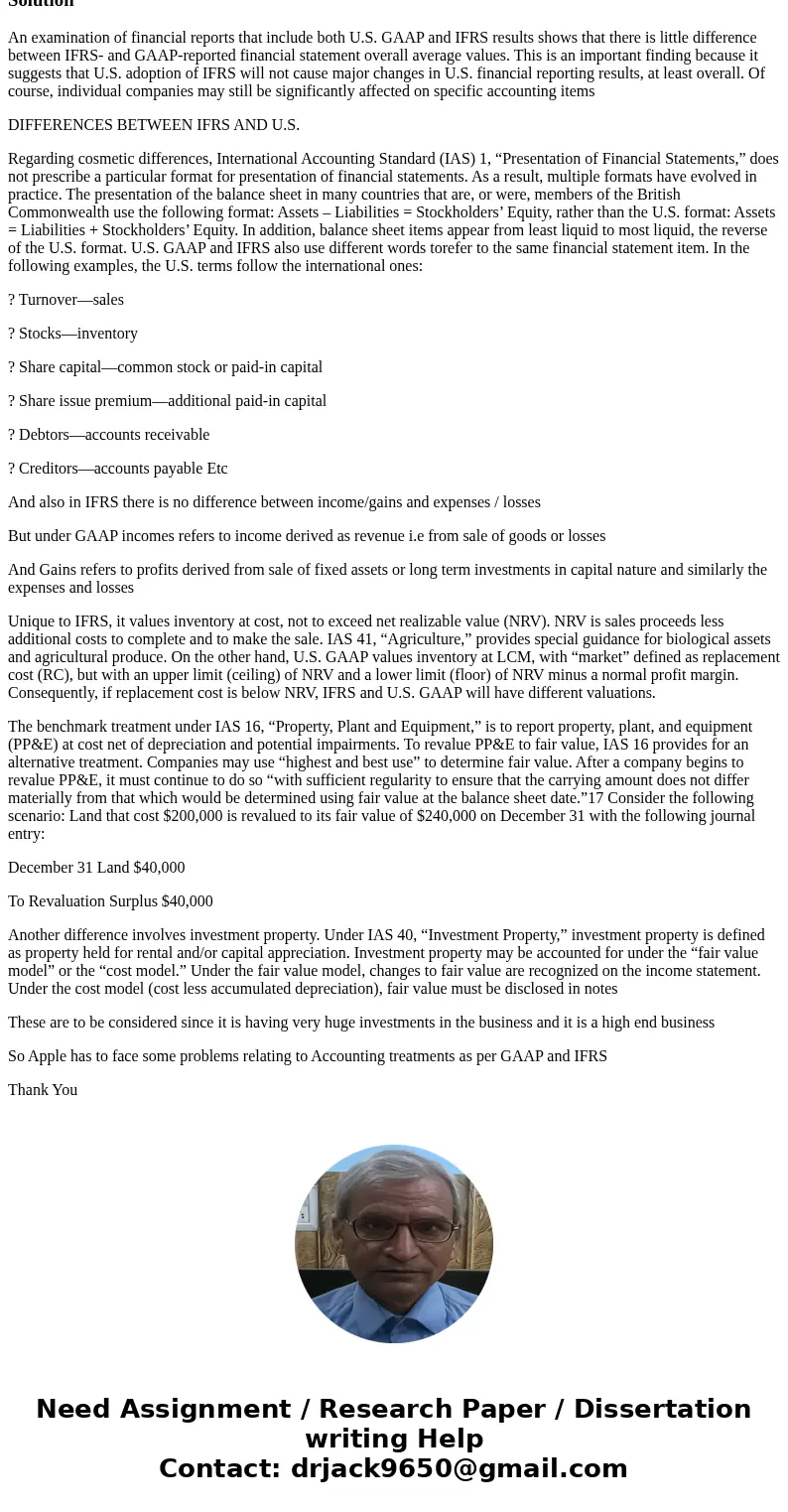httpsalertlogichb4ehbspharvardeduapicourses453898itemsUV7251
https://alertlogic-hb4e.hbsp.harvard.edu/api/courses/453898/items/UV7251-PDF-ENG/sclinks/317bdfc31125b75d7b8c9a1af172b26a
Other questions related to Apple:
Expand in some level of detail what types of accounting-related cultural issues Apple might face when operating in different countries around the world, especially with regards to the combination of local country statutory financial statement and related reporting requirements compared to the US GAAP reporting requirements.
Apple is obviously dealing with huge amounts of investments and cash, a large amount of which is located overseas and most likely invested in foreign currencies. Based upon what you have learned in this course, what are some of the foreign-currency management techniques Apple is most likely practicing in the management of these investments and cash sitting in bank and investment accounts across the globe? Be specific.
Solution
An examination of financial reports that include both U.S. GAAP and IFRS results shows that there is little difference between IFRS- and GAAP-reported financial statement overall average values. This is an important finding because it suggests that U.S. adoption of IFRS will not cause major changes in U.S. financial reporting results, at least overall. Of course, individual companies may still be significantly affected on specific accounting items
DIFFERENCES BETWEEN IFRS AND U.S.
Regarding cosmetic differences, International Accounting Standard (IAS) 1, “Presentation of Financial Statements,” does not prescribe a particular format for presentation of financial statements. As a result, multiple formats have evolved in practice. The presentation of the balance sheet in many countries that are, or were, members of the British Commonwealth use the following format: Assets – Liabilities = Stockholders’ Equity, rather than the U.S. format: Assets = Liabilities + Stockholders’ Equity. In addition, balance sheet items appear from least liquid to most liquid, the reverse of the U.S. format. U.S. GAAP and IFRS also use different words torefer to the same financial statement item. In the following examples, the U.S. terms follow the international ones:
? Turnover—sales
? Stocks—inventory
? Share capital—common stock or paid-in capital
? Share issue premium—additional paid-in capital
? Debtors—accounts receivable
? Creditors—accounts payable Etc
And also in IFRS there is no difference between income/gains and expenses / losses
But under GAAP incomes refers to income derived as revenue i.e from sale of goods or losses
And Gains refers to profits derived from sale of fixed assets or long term investments in capital nature and similarly the expenses and losses
Unique to IFRS, it values inventory at cost, not to exceed net realizable value (NRV). NRV is sales proceeds less additional costs to complete and to make the sale. IAS 41, “Agriculture,” provides special guidance for biological assets and agricultural produce. On the other hand, U.S. GAAP values inventory at LCM, with “market” defined as replacement cost (RC), but with an upper limit (ceiling) of NRV and a lower limit (floor) of NRV minus a normal profit margin. Consequently, if replacement cost is below NRV, IFRS and U.S. GAAP will have different valuations.
The benchmark treatment under IAS 16, “Property, Plant and Equipment,” is to report property, plant, and equipment (PP&E) at cost net of depreciation and potential impairments. To revalue PP&E to fair value, IAS 16 provides for an alternative treatment. Companies may use “highest and best use” to determine fair value. After a company begins to revalue PP&E, it must continue to do so “with sufficient regularity to ensure that the carrying amount does not differ materially from that which would be determined using fair value at the balance sheet date.”17 Consider the following scenario: Land that cost $200,000 is revalued to its fair value of $240,000 on December 31 with the following journal entry:
December 31 Land $40,000
To Revaluation Surplus $40,000
Another difference involves investment property. Under IAS 40, “Investment Property,” investment property is defined as property held for rental and/or capital appreciation. Investment property may be accounted for under the “fair value model” or the “cost model.” Under the fair value model, changes to fair value are recognized on the income statement. Under the cost model (cost less accumulated depreciation), fair value must be disclosed in notes
These are to be considered since it is having very huge investments in the business and it is a high end business
So Apple has to face some problems relating to Accounting treatments as per GAAP and IFRS
Thank You


 Homework Sourse
Homework Sourse